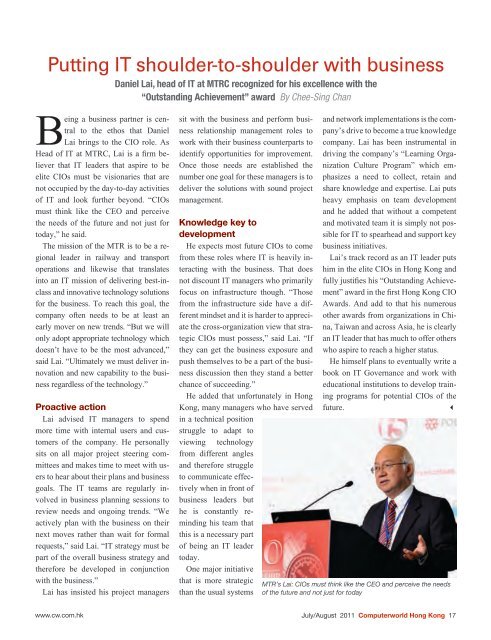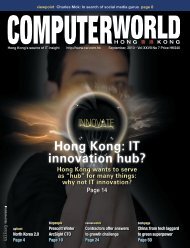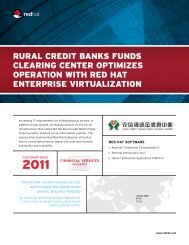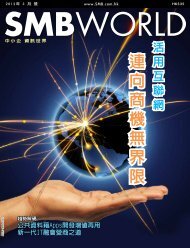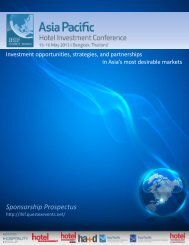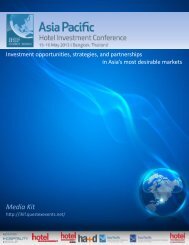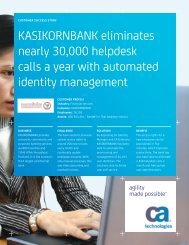Hong Kong's leading CIOs of 2011 - enterpriseinnovation.net
Hong Kong's leading CIOs of 2011 - enterpriseinnovation.net
Hong Kong's leading CIOs of 2011 - enterpriseinnovation.net
Create successful ePaper yourself
Turn your PDF publications into a flip-book with our unique Google optimized e-Paper software.
Putting IT shoulder-to-shoulder with business<br />
Daniel Lai, head <strong>of</strong> IT at MTRC recognized for his excellence with the<br />
“Outstanding Achievement” award By Chee-Sing Chan<br />
Being a business partner is central<br />
to the ethos that Daniel<br />
Lai brings to the CIO role. As<br />
Head <strong>of</strong> IT at MTRC, Lai is a firm believer<br />
that IT leaders that aspire to be<br />
elite <strong>CIOs</strong> must be visionaries that are<br />
not occupied by the day-to-day activities<br />
<strong>of</strong> IT and look further beyond. “<strong>CIOs</strong><br />
must think like the CEO and perceive<br />
the needs <strong>of</strong> the future and not just for<br />
today,” he said.<br />
The mission <strong>of</strong> the MTR is to be a regional<br />
leader in railway and transport<br />
operations and likewise that translates<br />
into an IT mission <strong>of</strong> delivering best-inclass<br />
and innovative technology solutions<br />
for the business. To reach this goal, the<br />
company <strong>of</strong>ten needs to be at least an<br />
early mover on new trends. “But we will<br />
only adopt appropriate technology which<br />
doesn’t have to be the most advanced,”<br />
said Lai. “Ultimately we must deliver innovation<br />
and new capability to the business<br />
regardless <strong>of</strong> the technology.”<br />
Proactive action<br />
Lai advised IT managers to spend<br />
more time with internal users and customers<br />
<strong>of</strong> the company. He personally<br />
sits on all major project steering committees<br />
and makes time to meet with users<br />
to hear about their plans and business<br />
goals. The IT teams are regularly involved<br />
in business planning sessions to<br />
review needs and ongoing trends. “We<br />
actively plan with the business on their<br />
next moves rather than wait for formal<br />
requests,” said Lai. “IT strategy must be<br />
part <strong>of</strong> the overall business strategy and<br />
therefore be developed in conjunction<br />
with the business.”<br />
Lai has insisted his project managers<br />
sit with the business and perform business<br />
relationship management roles to<br />
work with their business counterparts to<br />
identify opportunities for improvement.<br />
Once those needs are established the<br />
number one goal for these managers is to<br />
deliver the solutions with sound project<br />
management.<br />
Knowledge key to<br />
development<br />
He expects most future <strong>CIOs</strong> to come<br />
from these roles where IT is heavily interacting<br />
with the business. That does<br />
not discount IT managers who primarily<br />
focus on infrastructure though. “Those<br />
from the infrastructure side have a different<br />
mindset and it is harder to appreciate<br />
the cross-organization view that strategic<br />
<strong>CIOs</strong> must possess,” said Lai. “If<br />
they can get the business exposure and<br />
push themselves to be a part <strong>of</strong> the business<br />
discussion then they stand a better<br />
chance <strong>of</strong> succeeding.”<br />
He added that unfortunately in <strong>Hong</strong><br />
Kong, many managers who have served<br />
in a technical position<br />
struggle to adapt to<br />
viewing technology<br />
from different angles<br />
and therefore struggle<br />
to communicate effectively<br />
when in front <strong>of</strong><br />
business leaders but<br />
he is constantly reminding<br />
his team that<br />
this is a necessary part<br />
<strong>of</strong> being an IT leader<br />
today.<br />
One major initiative<br />
that is more strategic<br />
than the usual systems<br />
and <strong>net</strong>work implementations is the company’s<br />
drive to become a true knowledge<br />
company. Lai has been instrumental in<br />
driving the company’s “Learning Organization<br />
Culture Program” which emphasizes<br />
a need to collect, retain and<br />
share knowledge and expertise. Lai puts<br />
heavy emphasis on team development<br />
and he added that without a competent<br />
and motivated team it is simply not possible<br />
for IT to spearhead and support key<br />
business initiatives.<br />
Lai’s track record as an IT leader puts<br />
him in the elite <strong>CIOs</strong> in <strong>Hong</strong> Kong and<br />
fully justifies his “Outstanding Achievement”<br />
award in the first <strong>Hong</strong> Kong CIO<br />
Awards. And add to that his numerous<br />
other awards from organizations in China,<br />
Taiwan and across Asia, he is clearly<br />
an IT leader that has much to <strong>of</strong>fer others<br />
who aspire to reach a higher status.<br />
He himself plans to eventually write a<br />
book on IT Governance and work with<br />
educational institutions to develop training<br />
programs for potential <strong>CIOs</strong> <strong>of</strong> the<br />
future. 3<br />
MTR’s Lai: <strong>CIOs</strong> must think like the CEO and perceive the needs<br />
<strong>of</strong> the future and not just for today<br />
www.cw.com.hk<br />
July/August <strong>2011</strong> Computerworld <strong>Hong</strong> Kong 17


